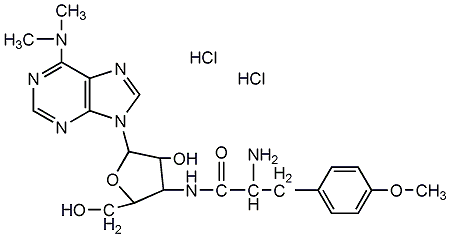
Structural formula
| Business number | 019L |
|---|---|
| Molecular formula | C22H29N7O5·2HCl |
| Molecular weight | 544.43 |
| label |
Puromycin dihydrochloride hydrate |
Numbering system
CAS number:58-58-2
MDL number:MFCD00067313
EINECS number:200-387-8
RTECS number:AU7355000
BRN number:None
PubChem ID:None
Physical property data
1. Characteristics: Crystalline. Hygroscopic. Sensitive to light.
2. Density ( g/mL,25/4℃) : Undetermined
3. relative Vapor density (g/mL,Air=1 ): Undetermined
4. Melting point ( ºC): 175.5~177.0
5. Boiling point ( ºC,Normal pressure): Undetermined
6. Boiling point ( ºC): 140-150℃(1.33×10-5kPa)
7. Refractive Index: Undetermined
8. Flashpoint (ºC): Undetermined
9. Specific optical rotation (º): -11
10. Autoignition point or ignition temperature (ºC): Not OK
11. Vapor pressure (kPa,25ºC): Undetermined
12. Saturation vapor pressure (kPa,60ºC): Undetermined
18. Lower explosion limit (%,V/V): Not OK
19. Solubility: Easily soluble in water.
Toxicological data
1, acute toxicity: mice oral LD50: 720mg/kg; mouse abdominal cavity LD50: 580mg/kg; mouse intravenous LD50: .335mg/kg; Guinea pig oral LD50: 600mg/kg;
Guinea pig abdominal cavity LD50: 287mg/kg; guinea pig intramuscular LD50:202mg/kg
2, other multiple dose toxicity: rat Abdominal TDLo: 1mg/kg/10D-I; Dog intramuscular TDLo >:150mg/kg/3D-I
3 , mutagenicity: DNA inhibition test: mouse abdominal cavity: 333mg/kg; mutation Test system – and not otherwise specified: Mouse abdominal cavity: 333mg/kg;
Cytogenetic analysis: Mouse peritoneal cavity: 100mg/kg
Ecological data
None
Molecular structure data
5. Molecular property data:
1. Molar refractive index: 120.56
<SPAN lang=EN-US styl
Compute chemical data
None
Properties and stability
None
Storage method
This product should be sealed with argon gas0 Store in a dry place below ℃ and away from light.
Synthesis method
By Streptococcus albicans (Streptomyces.alboniger) fermentation.
Purpose
Biochemical research. Protein synthesis inhibitor. Prevents the growth of bacteria, algae, protists and mammalian cells.
S> Cytogenetic analysis: Mouse peritoneal cavity: 100mg/kg
Ecological data
None
Molecular structure data
5. Molecular property data:
1. Molar refractive index: 120.56
<SPAN lang=EN-US styl
Compute chemical data
None
Properties and stability
None
Storage method
This product should be sealed with argon gas0 Store in a dry place below ℃ and away from light.
Synthesis method
By Streptococcus albicans (Streptomyces.alboniger) fermentation.
Purpose
Biochemical research. Protein synthesis inhibitor. Prevents the growth of bacteria, algae, protists and mammalian cells.

 微信扫一扫打赏
微信扫一扫打赏

